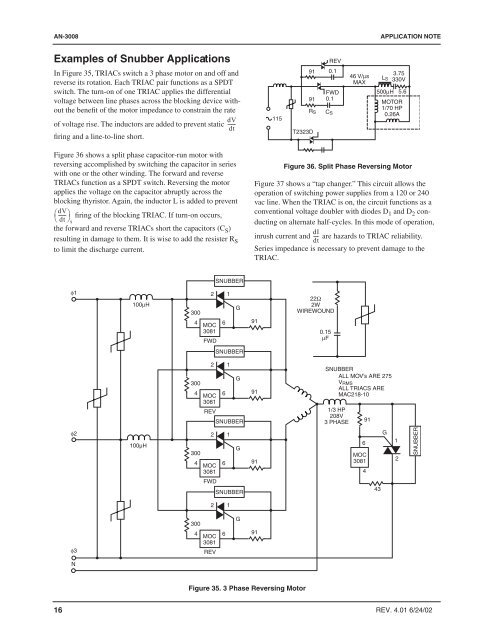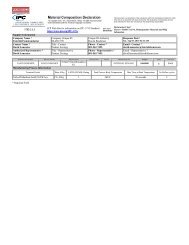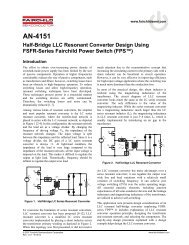AN-3008 RC Snubber Networks for Thyristor Power Control and ...
AN-3008 RC Snubber Networks for Thyristor Power Control and ...
AN-3008 RC Snubber Networks for Thyristor Power Control and ...
You also want an ePaper? Increase the reach of your titles
YUMPU automatically turns print PDFs into web optimized ePapers that Google loves.
<strong>AN</strong>-<strong>3008</strong><br />
APPLICATION NOTE<br />
Examples of <strong>Snubber</strong> Applications<br />
REV<br />
In Figure 35, TRIACs switch a 3 phase motor on <strong>and</strong> off <strong>and</strong><br />
reverse its rotation. Each TRIAC pair functions as a SPDT<br />
switch. The turn-on of one TRIAC applies the differential<br />
voltage between line phases across the blocking device without<br />
the benefit of the motor impedance to constrain the rate<br />
dV<br />
of voltage rise. The inductors are added to prevent static ------<br />
dt<br />
firing <strong>and</strong> a line-to-line short.<br />
115<br />
91 0.1<br />
91<br />
R S<br />
T2323D<br />
FWD<br />
0.1<br />
C S<br />
46 V/µs<br />
MAX<br />
L S<br />
3.75<br />
330V<br />
500µH 5.6<br />
MOTOR<br />
1/70 HP<br />
0.26A<br />
Figure 36 shows a split phase capacitor-run motor with<br />
reversing accomplished by switching the capacitor in series<br />
with one or the other winding. The <strong>for</strong>ward <strong>and</strong> reverse<br />
TRIACs function as a SPDT switch. Reversing the motor<br />
applies the voltage on the capacitor abruptly across the<br />
blocking thyristor. Again, the inductor L is added to prevent<br />
⎛dV<br />
------ ⎞<br />
⎝<br />
firing of the blocking TRIAC. If turn-on occurs,<br />
dt ⎠s<br />
the <strong>for</strong>ward <strong>and</strong> reverse TRIACs short the capacitors (C S )<br />
resulting in damage to them. It is wise to add the resister R S<br />
to limit the discharge current.<br />
Figure 36. Split Phase Reversing Motor<br />
Figure 37 shows a “tap changer.” This circuit allows the<br />
operation of switching power supplies from a 120 or 240<br />
vac line. When the TRIAC is on, the circuit functions as a<br />
conventional voltage doubler with diodes D 1 <strong>and</strong> D 2 conducting<br />
on alternate half-cycles. In this mode of operation,<br />
dI<br />
inrush current <strong>and</strong> ---- are hazards to TRIAC reliability.<br />
dt<br />
Series impedance is necessary to prevent damage to the<br />
TRIAC.<br />
SNUBBER<br />
φ1<br />
100µH<br />
300<br />
4<br />
MOC<br />
3081<br />
FWD<br />
2 1<br />
6<br />
G<br />
91<br />
22Ω<br />
2W<br />
WIREWOUND<br />
0.15<br />
µF<br />
SNUBBER<br />
300<br />
4<br />
MOC<br />
3081<br />
REV<br />
2 1<br />
6<br />
G<br />
SNUBBER<br />
91<br />
SNUBBER<br />
ALL MOV’s ARE 275<br />
V RMS<br />
ALL TRIACS ARE<br />
MAC218-10<br />
1/3 HP<br />
208V<br />
3 PHASE<br />
91<br />
φ2<br />
100µH<br />
300<br />
4<br />
MOC<br />
3081<br />
FWD<br />
2 1<br />
6<br />
G<br />
SNUBBER<br />
91<br />
6<br />
MOC<br />
3081<br />
4<br />
43<br />
G<br />
1<br />
2<br />
SNUBBER<br />
2 1<br />
φ3<br />
300<br />
4<br />
MOC<br />
3081<br />
REV<br />
6<br />
G<br />
91<br />
N<br />
Figure 35. 3 Phase Reversing Motor<br />
16 REV. 4.01 6/24/02







